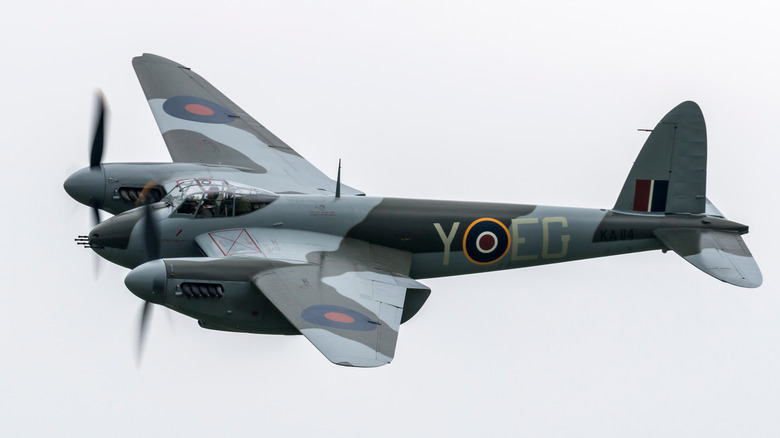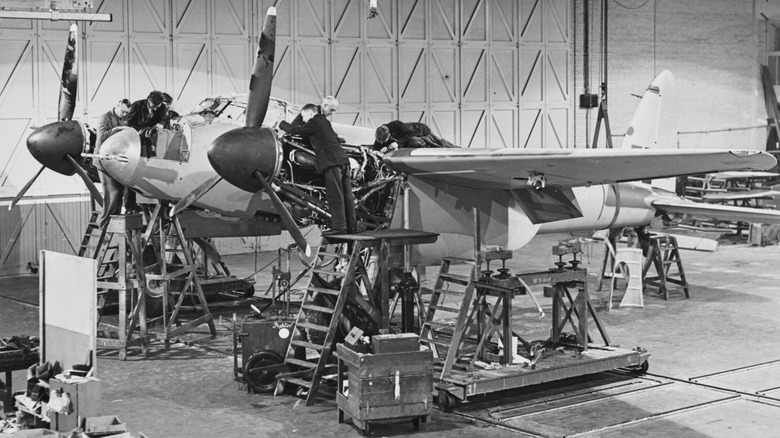The Wooden Wonder Plane That Defied Traditional Aircraft Design
The DH 98 Mosquito (aka "Mossie") was one of the most adaptable aircraft used during World War II, with at least forty-two uniquely different versions built and operated by the British and her Allies. Odd, not only because it flew directly in the face of conventional aircraft design but because the British Air Ministry was "vehemently" against using it at first (via Smithsonian National Air and Space Museum).
De Havilland Aircraft Company, one of the most iconic plane builders in the world (via BAE Systems), was responsible for the Mosquito. A plane so popular with the Allies and so notorious to the Germans that it eventually became known as "The Wooden Wonder."
Ironically, it did not start life as a military warplane but evolved from two pre-existing de Havilland planes. In 1934 the twin-engine 88 Comet was built to participate in the England-Australia Air Race. With a wing and fuselage made from an "advanced plywood skin," it won the first race it entered. Then, in 1938, Imperial Airways put seven of de Havilland's four-engine 91 Albatross air transports into service. Among its innovations, the fuselage was constructed using a robust wooden composite.
When WWII began in September 1939, the world turned its attention to stopping Hitler and his Nazi regime.
This Wooden Wonder was literally glued and screwed together
Founder Geoffrey de Havilland said, "We believe that we could produce a twin-engine bomber which would have a performance so outstanding that little defensive equipment would be needed" (via BAE Systems). He and his company began designing the bomber based on techniques they learned from the Comet and Albatross (via Smithsonian National Air and Space Museum).
As the war progressed, raw construction materials became harder to find, so the British Air Ministry put a stronger emphasis on using different materials to build its war machines. It also made a big push towards requiring that equipment, including aircraft, to have multi-purpose capabilities (via BAE Systems).
After de Havilland had successfully proven itself with other war efforts, the British Air Ministry conceded to constructing the DH 98 Mosquito (via BAE Systems). The Mosquito used a wooden frame with plywood skin (via Britannica), or, as the National Museum of the United States Air Force put it, was built "primarily of plywood with a balsa wood core."
Basically, it was nothing more than a massive version of a kid's balsa wood airplane. Actually, a mixture of Alaskan spruce, English ash, Canadian birch and fir, and Ecuadorian balsa was "glued and screwed together" (via Smithsonian National Air and Space Museum). Its natural buoyancy allowed it to float for hours after crashing (via Bomberguy).
A Mosquito did all the heavy lifting
Two reciprocating, liquid-cooled V12 Rolls Royce Merlin engines producing a combined 1,690hp powered the "The Wooden Wonder" through the air. The Mosquito was lightweight but could carry 4,000 pounds of bombs, go 415 miles per hour, and had a range of almost 2,000 miles (via Smithsonian National Air and Space Museum).
Flight trials began on November 25, 1940 (via National Museum of the United States Air Force), a mere 11 months after getting the green light. A Mosquito flew a photo-reconnaissance mission above the western border of France and Spain on September 17, 1941. Before that year was up, de Havilland had built twenty production aircraft (via Smithsonian National Air and Space Museum). Early in 1942, fighter and bomber versions began flying sorties across the Western European theater, less than two years after getting the go-ahead from the British Air Ministry (via Bomberguy).
Nearly 8,000 "Mossies" were built in Great Britain, Canada, and Australia during the war (via National Museum of the United States Air Force). The United States Air Force (via National Museum of the United States Air Force) used nearly 150. The Mosquito flew its last operational mission on May 21, 1945 (via BAE Systems).

